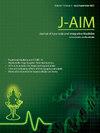Ashwagandha, Withania somnifera (L.) Dunal, for the prophylaxis against SARS-CoV-2 infection: A multicentric randomized hydroxychloroquine controlled clinical trial in Indian health care workers
IF 1.9
Q3 INTEGRATIVE & COMPLEMENTARY MEDICINE
引用次数: 0
Abstract
Background
The study was planned when, the hydroxychloroquine (HCQ) was the only prophylactic agent approved by health authorities in several countries and no prophylactic COVID-19 vaccine was available.
Objective
The present study aimed to evaluate efficacy of Withania Somnifera (L.) Dunal (WS) as a chemoprophylactic and immunomodulatory agent against SARS-CoV-2 infection.
Methods
In a 12 week, randomized, open label, parallel group, two arm, comparative, multicentric, controlled trial compared WS with hydroxychloroquine (HCQ) in health care workers (HCWs). Total 400 HCWs were randomized in 1:1 ratio to receive either oral WS (500 mg for 12 weeks) or HCQ 400 mg (for 7 weeks). The primary outcome was to establish equivalence between WS and HCQ for the proportion of participants contracting SARS-CoV-2 infection.
Results
Seven participants contracted SARS-CoV-2 infection: 5 in WS arm and 2 in HCQ arm. The equivalence between WS and HCQ was established for the proportion difference of participants contracting SARS-CoV-2 infection for per-protocol (PP) (1.6%, 95% CI: −1.08%–4.33%) and in subgroup analysis (ITT, mIIT, non-vaccinated and seronegative).
Notably, the immunomodulatory effect of WS stood scientifically validated by the statistically significant difference in cytokine levels (p < 0.0001) at 12 weeks compared to baseline for Tumor Necrosis Factor (TNF)-alpha, Interleukin (IL)-2, IL-10, IL-17 and Monocyte chemoattractant protein-1 (MCP-1).
Gastrointestinal-related AEs were most frequent (53 in WS and 58 in HCQ). Headache and sneezing were observed only with HCQ. Participant global assessment showed excellent tolerability with both treatment arms.
Conclusion
WS was found equivalent to HCQ as a prophylactic against SARS-CoV-2 infection with no safety concern. WS is thus inferred to be an effective and safe Ayurvedic intervention for prophylaxis against SARS-CoV-2 infection, and also as an immunobooster.

Ashwagandha, Withania somnifera (L.)预防SARS-CoV-2感染:一项在印度卫生保健工作者中进行的多中心随机羟氯喹对照临床试验
在计划开展这项研究时,羟氯喹(HCQ)是几个国家卫生当局批准的唯一预防药物,而且没有预防性COVID-19疫苗。目的评价苦参草(Withania Somnifera, L.)的药理作用。Dunal (WS)作为SARS-CoV-2感染的化学预防和免疫调节剂。方法在一项为期12周、随机、开放标签、平行组、双臂、比较、多中心、对照试验中,对医护人员(HCWs)使用WS与羟氯喹(HCQ)进行比较。总共400名HCWs按1:1的比例随机分配,接受口服WS (500 mg,持续12周)或HCQ 400 mg(持续7周)。主要结果是确定WS和HCQ在参与者感染SARS-CoV-2的比例之间的等效性。结果7例受试者感染SARS-CoV-2: WS组5例,HCQ组2例。在每个方案(PP) (1.6%, 95% CI: - 1.08%-4.33%)和亚组分析(ITT、mIIT、未接种疫苗和血清阴性)中,建立了WS和HCQ之间的等效性。值得注意的是,WS的免疫调节作用得到了科学的验证,细胞因子水平的统计学差异(p <;与基线相比,肿瘤坏死因子(TNF)- α、白细胞介素(IL)-2、IL-10、IL-17和单核细胞化学引诱蛋白-1 (MCP-1)在12周时降低0.0001)。胃肠道相关ae最常见(WS 53例,HCQ 58例)。头痛和打喷嚏仅在HCQ组出现。参与者总体评估显示两个治疗组的耐受性都很好。结论ws与HCQ在预防SARS-CoV-2感染方面具有等效作用,无安全性问题。因此,WS被推断为一种有效和安全的阿育吠陀预防SARS-CoV-2感染的干预措施,也是一种免疫增强剂。
本文章由计算机程序翻译,如有差异,请以英文原文为准。
求助全文
约1分钟内获得全文
求助全文
来源期刊

Journal of Ayurveda and Integrative Medicine
INTEGRATIVE & COMPLEMENTARY MEDICINE-
CiteScore
4.70
自引率
12.50%
发文量
136
审稿时长
30 weeks
 求助内容:
求助内容: 应助结果提醒方式:
应助结果提醒方式:


